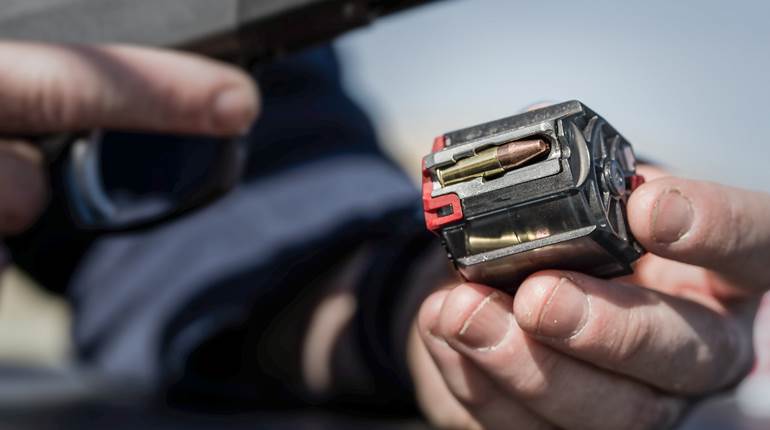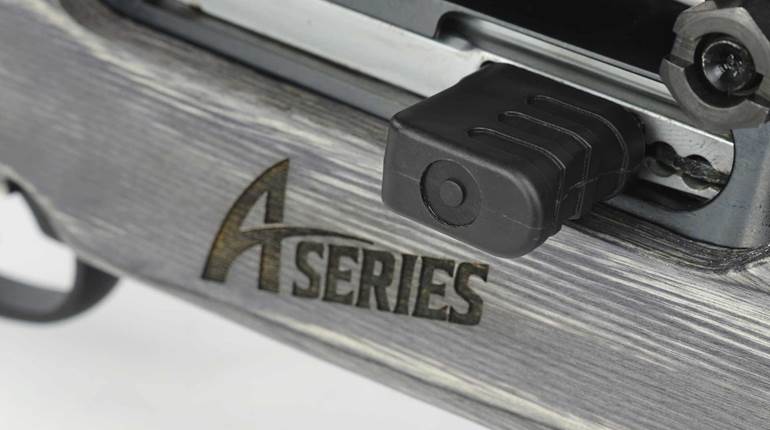
An early example is the raid on the Dr. John Woodson home in Jamestown, Va. The Woodsons had come to the New World in 1619 on the George. In 1644, Sarah Woodson was at home with her two young sons and a neighbor, Ligon. Her husband, returning home after attending to a patient, was attacked and killed by Indian marauders within sight of his family.

Sarah quickly barricaded the house and handed Ligon a musket. She hid her son Robert under the washtub, and her other son, John, in the potato hole. When two Indians came down the chimney, Sarah scalded one with a pot of boiling water, and brained the other with an iron roasting spit. Ligon is said to have killed a total of 11 of the attackers with the musket before the Indians retreated.
Descendants of the Woodson boys identified themselves as the “Washtub” Woodsons and the “Potato Hole” Woodsons. Among them were the notorious frontier outlaws from Missouri, Jesse and Frank James.
Guns And Women In Pioneer America
Although in some ways an inconsistent source, probate records occasionally reveal that the use of firearms was not limited to men in pre-Civil War days. The estate of Connecticut citizen Thomas Scott “was divided into two sections: one listing goods ‘delivered to the Wydow Scott for her use,’ and another listing ‘Goods of Tho: Scots sett aparte for his 3 daughters.’ Mrs. Scott received a fowling piece, a matchlock musket, a sword, and a pair of bandalers. The three daughters received a snaphance flintlock and ‘1 cok mach musket,’ apparently a matchlock.”
Historian Clayton Cramer has compiled an immense amount of data on the subject of pre-Civil War arms, and analysis of the information is helping to construct a picture of women and firearms from this obscure period. One striking discovery was the Reverend William C. Smith’s frontier account, Indiana Miscellany. In it, Smith observes that, despite a shortage of provisions during the War of 1812, “usually they had plenty of meat. All the men were excellent hunters—some of them real experts … . Some of [the women] could handle the rifle with great skill, and bring down the game in the absence of their husband ... .”

The 1818-19 journal of Henry Rowe Schoolcraft noted that Ozark children, on reaching the age of 14, “have completely learned the use of the rifle, the arts of dressing skins and making [moccasins] and leather clothes.” His observation likely included girls as well as boys, because he also states that he failed at making small talk with his hostess and her daughters: “They could only talk of bears, hunting, and the like. The rude pursuits, and the coarse enjoyments of the hunter state, were all they knew.”
Cramer reports that at one isolated cabin, the lady of the house was home alone, and instructed Schoolcraft and his companion not only about “errors in our dress, equipments, and mode of travelling,” but also “that our [shotguns] were not well adapted to our journey; that we should have rifles … .” Schoolcraft and his companion were astonished “to hear a woman direct us in matters which we had before thought the peculiar and exclusive province of men.” It is very clear that Ozark women as hunters surprised a New Englander such as Schoolcraft, but his comments also imply that what was surprising was the sex of his instructor, not widespread knowledge of hunting and firearms.
Even as late as the 1820s, frontier America could reflect on some 200 years of hardship, and was destined to encounter yet another century of the same, producing a unique culture of self-reliance, independence, and hardiness that remains cherished to this day by millions of American women.
The Untimely Fate Of A Huntress
Young Lottie Merrill, of Wayne County, Pa., had a reputation as an accomplished huntress—the New York Sun had published an account of her killing two black bears. When she was subsequently killed by her prey, The Chicago Field related the grisly details on April 9, 1881.
“The Untimely Fate of a Huntress … . Miss Merrill has met a most tragic death, having been attacked in her hut by six bears, killed and eaten by them, and her remains, with the carcasses of her assailants, having been consumed by the burning of her cabin after the termination of the fatal combat.
It appears she had, on the day of her death, killed a fine buck, which she had dragged home on the snow. Six hungry bears, attracted by the smell of the blood, had followed the trail to Miss Merrill’s cabin, and, it is presumed, attacked her after devouring the carcass of the deer. The brave girl had undoubtedly made a heroic defense, as she had evidently killed two of the bears before being overpowered.

The carcass of one bear had fallen against the cabin door, on the inside, imprisoning them all, when the cabin took fire and destroyed both the girl and her assailants. Within the cabin was found one of her hunting boots, her foot still remaining in it, her bent hunting knife, and the antlers of her last deer. Over three hundred persons attended her funeral.
She was buried near her burned cabin, and upon her grave were placed a pair of antlers and a hemlock slab, bearing the following epitaph: ‘Lottie Merrill lays here. She didn’t know what it was to be afeerd, but she had her last tussel with the bars, and they have scooped her. She was a good girl, and she is now in heaven. It took six bars to get away with her. She was only 18 years old.’”
Ida Wells-Barnett—Pioneer Crusader For Civil Rights—Carried A Pistol
In Georgia, in 1899, Sam Hose was thought to have murdered a white man, and was lynched by a mob of 2,000 whites. Ida Wells-Barnett, of Memphis, Tenn., researched the charges and proved that Hose was innocent. When she wrote editorials in her newspaper denouncing the lynchings of blacks by white mobs, the paper was raided, the presses wrecked, and the building torched.

Wells-Barnett traveled to many Southern towns investigating lynchings, and her campaign helped to lay the groundwork for the American civil rights movement. Armed with a handgun for self-defense, Wells-Barnett was quoted as boldly stating: “I felt if I could take one lyncher with me, this would even up the score a little bit.” She also maintained that “a Winchester rifle should have a place of honor in every black house.”
Women And Arms In The Old West
Sturdy, independent, daring and adventurous were the women who made the trek to the American West. From 1841 to 1866, approximately 350,000 emigrants traveled the 2,400 miles by wagon from the Missouri River all the way to California and Oregon. Knowing how to use a gun was as necessary as knowing how to deal with all the other chores of pioneer life.
Symbolic of the bold way in which many women embraced the West was the experience of Martha Maxwell, “the Colorado Huntress.” Credited by many authorities as the founder of modern taxidermy, she was America’s premier female naturalist. She caused a sensation at the Philadelphia Centennial Exhibition of 1876 with her extraordinary wildlife displays, which featured animals in natural poses within their habitats. The Kansas and Colorado Building featured “Woman’s Work,” a breathtaking presentation of her trophies, hunted and collected by herself. Mounted in a Western setting were elk, deer, mountain lions, mountain sheep and an array of other North American game.

Her skills had been inspired by a combination of a love of wild animals, a keen instinct as a huntress, and a sculptor’s eye at immortalizing her prey. At the age of 10, in her Wisconsin home, she grabbed a gun and shot a rattlesnake ready to strike her 4-year-old sister. As a young woman, she married lumberman James Maxwell, and in 1860, they emigrated to Colorado. As a hunting companion to her husband, she became a dedicated outdoorswoman. The work of a local taxidermist gave impetus to Maxwell’s determination to excel in that difficult field dominated, of course, by men.
Her home in Boulder served as a site for exhibiting her masterful creations. In 1873, the city offered her an exhibition hall, which became the Rocky Mountain Museum. In 1875, the museum moved to Denver, and soon thereafter she was invited to put on the Centennial Exhibition presentation. Yet another accolade was the naming of the Rocky Mountain screech owl—Scops maxwelae—in her honor because she was credited with its discovery as a distinct species.
At the time of the exhibition in Philadelphia, the Evans Rifle Manufacturing Company of Mechanics Falls, Maine, presented Maxwell with a rifle. On accepting the rifle, she stated: “The use of this rare gift shall be directed by a love of science and in pursuit of objects for the study of natural history; it shall be my trusted companion and assistant.” Her sentiments were in stark contrast to those of Texas Jack, who claimed, in a promotional statement about his Evans, “I can clean out a whole band of Indians … with it.”
Ella Bird-Dumont: A Deadly Shot With Her Winchester Model 1873 Rifle
J.T. Bird was a celebrated Texas Ranger, one of 10 recipients of a presentation-inscribed Winchester Model 1873 rifle from the Texas legislature. He little knew that it would become the treasured possession of his bride-to-be.
Resigning from the Rangers around 1876, he pursued a wintertime whirlwind courtship of Ella Elger, of Young County. Of their first meeting she would remember fondly: “There I beheld mounted on the most beautiful large black horse … a man in full western costume, that of a Texas ranger … . He had with him a fine Winchester rifle of the latest model which was awarded him by the legislature in 1873 for an Indian fight. It had a silver shield on it with his name engraved … .”
In 1877, they married. Bird rejoined the Rangers that March, and the following December they headed to the buffalo-hunting range. Now using a Sharps heavy-barrel rifle, Bird presented the Winchester 1873 to his wife. She later recalled: “[He] was anxious that I should learn to use a gun. ... Most every afternoon, when [he] came in off the hunt, Mr. Bird would give me training with my rifle shooting at targets. ... I never neglected practicing [and] was about ready to banter my husband for a shooting match.”

She soon became one of West Texas’ best shots, and could shoot off the heads of prairie dogs. She claimed to have killed three wild turkeys with a single shot, and twice she killed a buffalo with a single shot. When her husband died in a blizzard in 1888, she kept meat on the table with that Winchester. She also made gauntlets and vests for cattlemen of the area from skins of deer and antelope she had shot. Wildcats and lobo wolves fell to her sharpshooting in the 1890s.
An attractive and still youthful widow, Ella Bird found that her prowess as a shot stood her in good stead in chasing off unwanted suitors. On one occasion, she walked out to meet a cowboy, holding her rifle at her shoulder. Her warning was “Keep riding,” which he did—already knowing of her reputation as a crack shot. As stated by another: “Sure, I would rather any man in Cottle County would shoot at me than Mrs. Bird.”
In 1897, Ella Bird remarried and settled in Paducah, Texas, where the rifle continued to serve her well. In 1934, Mrs. Ella Bird-Dumont presented the Winchester to the Panhandle Plains Historical Museum, where it symbolizes the valiant women, all too often forgotten, whose courage helped to tame the wild frontier.




































